TDA 3.30: Supporting Children and Young Adults - Assignment Solution
VerifiedAdded on 2020/12/09
|5
|1135
|367
Homework Assignment
AI Summary
This document provides a comprehensive solution for the TDA 3.30 assignment, focusing on working with other practitioners to support children and young adults. It addresses key aspects such as the importance of multi-agency and integrated working, identifying external agencies and professionals involved, outlining roles and responsibilities within and outside the setting, and explaining the practitioner's role in various group situations. The solution also emphasizes the importance of respecting other professionals' contributions, adhering to professional boundaries, and understanding the setting's policies and procedures for contact with external agencies. Furthermore, it explains when and why to refer to other sources for information, advice, or support within the setting, providing a complete overview of the topics covered in the assignment. The solution references relevant books and journals to support the answers provided.
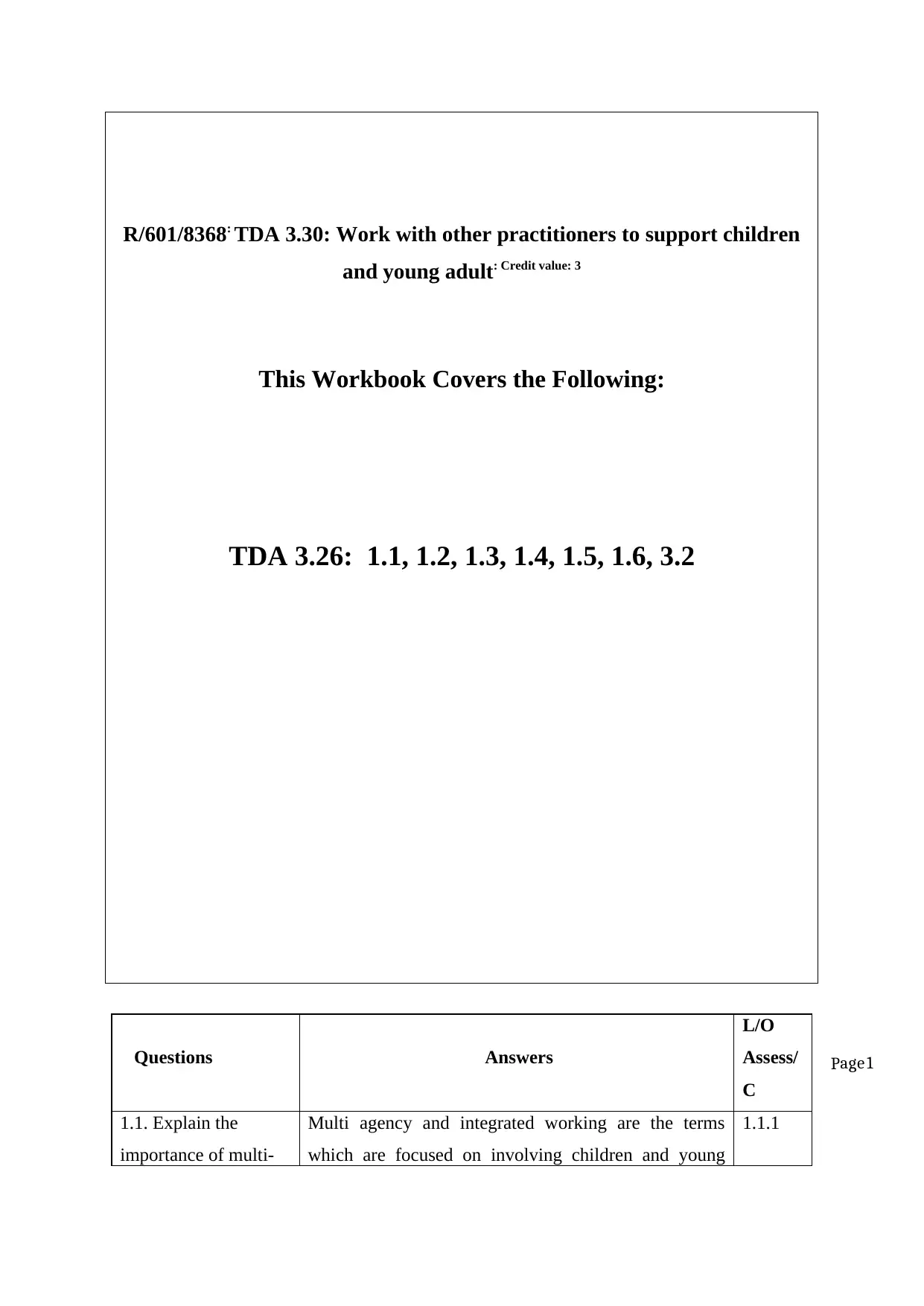
Page1
R/601/8368: TDA 3.30: Work with other practitioners to support children
and young adult: Credit value: 3
This Workbook Covers the Following:
TDA 3.26: 1.1, 1.2, 1.3, 1.4, 1.5, 1.6, 3.2
Questions Answers
L/O
Assess/
C
1.1. Explain the
importance of multi-
Multi agency and integrated working are the terms
which are focused on involving children and young
1.1.1
R/601/8368: TDA 3.30: Work with other practitioners to support children
and young adult: Credit value: 3
This Workbook Covers the Following:
TDA 3.26: 1.1, 1.2, 1.3, 1.4, 1.5, 1.6, 3.2
Questions Answers
L/O
Assess/
C
1.1. Explain the
importance of multi-
Multi agency and integrated working are the terms
which are focused on involving children and young
1.1.1
Paraphrase This Document
Need a fresh take? Get an instant paraphrase of this document with our AI Paraphraser
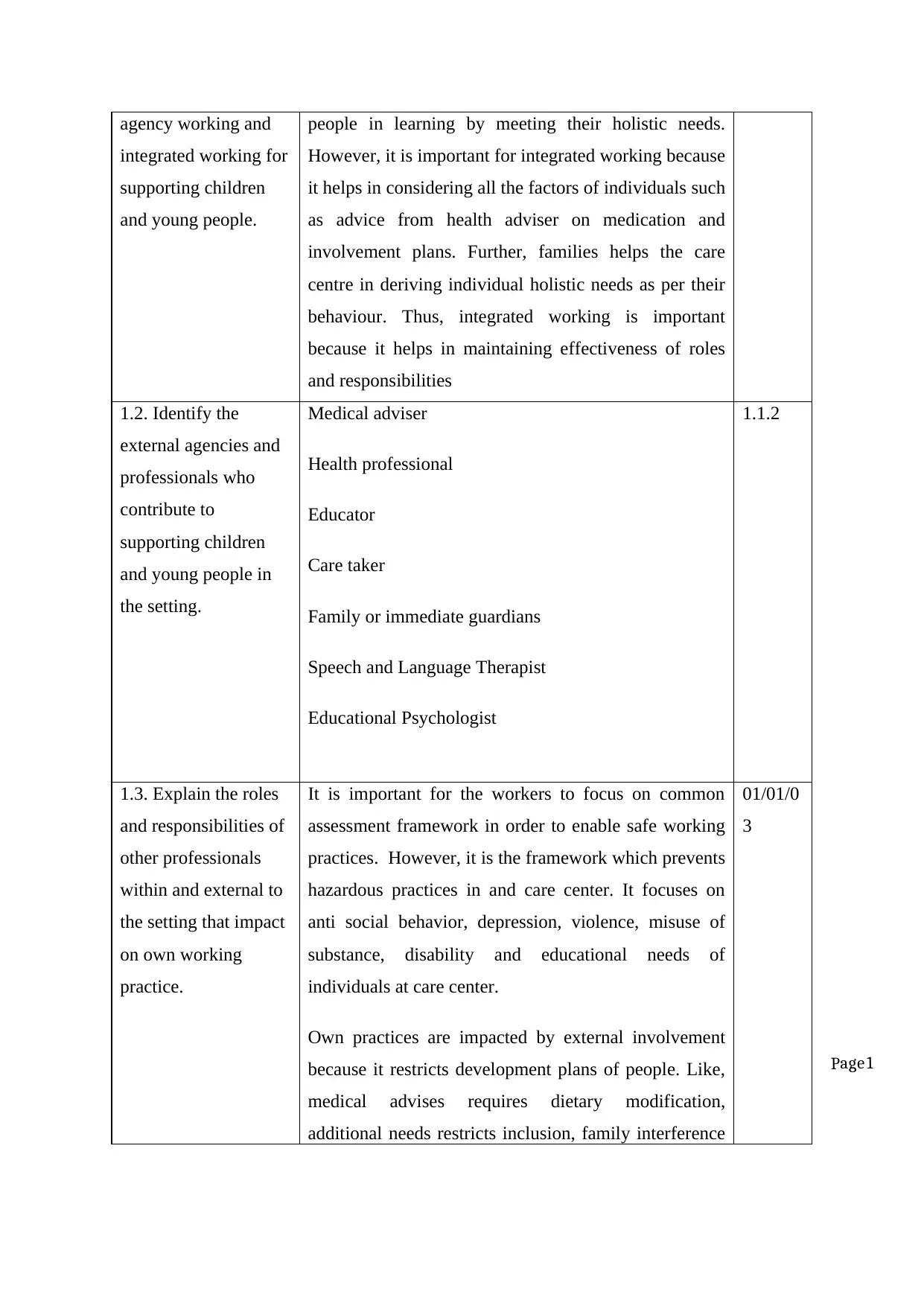
Page1
agency working and
integrated working for
supporting children
and young people.
people in learning by meeting their holistic needs.
However, it is important for integrated working because
it helps in considering all the factors of individuals such
as advice from health adviser on medication and
involvement plans. Further, families helps the care
centre in deriving individual holistic needs as per their
behaviour. Thus, integrated working is important
because it helps in maintaining effectiveness of roles
and responsibilities
1.2. Identify the
external agencies and
professionals who
contribute to
supporting children
and young people in
the setting.
Medical adviser
Health professional
Educator
Care taker
Family or immediate guardians
Speech and Language Therapist
Educational Psychologist
1.1.2
1.3. Explain the roles
and responsibilities of
other professionals
within and external to
the setting that impact
on own working
practice.
It is important for the workers to focus on common
assessment framework in order to enable safe working
practices. However, it is the framework which prevents
hazardous practices in and care center. It focuses on
anti social behavior, depression, violence, misuse of
substance, disability and educational needs of
individuals at care center.
Own practices are impacted by external involvement
because it restricts development plans of people. Like,
medical advises requires dietary modification,
additional needs restricts inclusion, family interference
01/01/0
3
agency working and
integrated working for
supporting children
and young people.
people in learning by meeting their holistic needs.
However, it is important for integrated working because
it helps in considering all the factors of individuals such
as advice from health adviser on medication and
involvement plans. Further, families helps the care
centre in deriving individual holistic needs as per their
behaviour. Thus, integrated working is important
because it helps in maintaining effectiveness of roles
and responsibilities
1.2. Identify the
external agencies and
professionals who
contribute to
supporting children
and young people in
the setting.
Medical adviser
Health professional
Educator
Care taker
Family or immediate guardians
Speech and Language Therapist
Educational Psychologist
1.1.2
1.3. Explain the roles
and responsibilities of
other professionals
within and external to
the setting that impact
on own working
practice.
It is important for the workers to focus on common
assessment framework in order to enable safe working
practices. However, it is the framework which prevents
hazardous practices in and care center. It focuses on
anti social behavior, depression, violence, misuse of
substance, disability and educational needs of
individuals at care center.
Own practices are impacted by external involvement
because it restricts development plans of people. Like,
medical advises requires dietary modification,
additional needs restricts inclusion, family interference
01/01/0
3
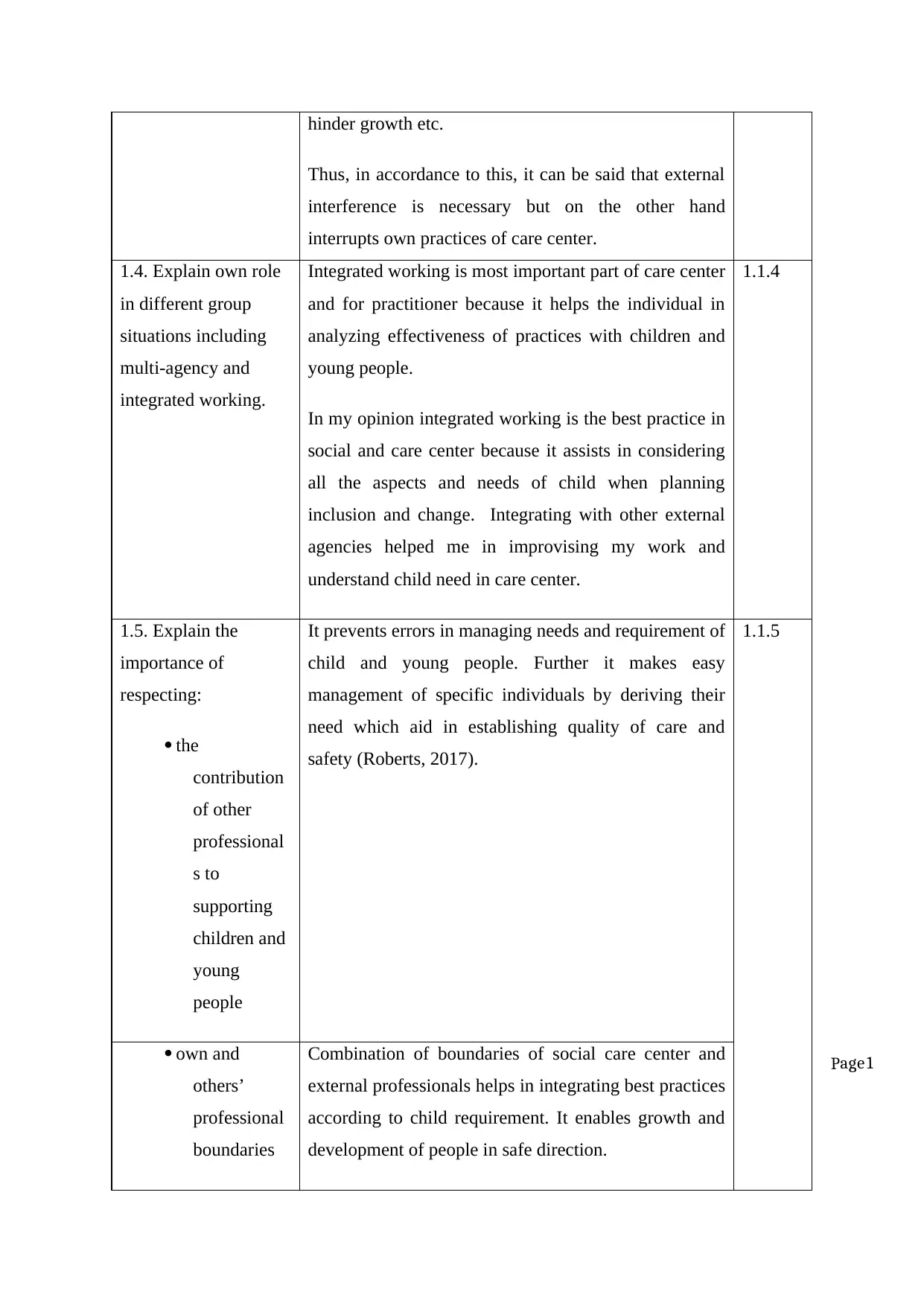
Page1
hinder growth etc.
Thus, in accordance to this, it can be said that external
interference is necessary but on the other hand
interrupts own practices of care center.
1.4. Explain own role
in different group
situations including
multi-agency and
integrated working.
Integrated working is most important part of care center
and for practitioner because it helps the individual in
analyzing effectiveness of practices with children and
young people.
In my opinion integrated working is the best practice in
social and care center because it assists in considering
all the aspects and needs of child when planning
inclusion and change. Integrating with other external
agencies helped me in improvising my work and
understand child need in care center.
1.1.4
1.5. Explain the
importance of
respecting:
the
contribution
of other
professional
s to
supporting
children and
young
people
It prevents errors in managing needs and requirement of
child and young people. Further it makes easy
management of specific individuals by deriving their
need which aid in establishing quality of care and
safety (Roberts, 2017).
1.1.5
own and
others’
professional
boundaries
Combination of boundaries of social care center and
external professionals helps in integrating best practices
according to child requirement. It enables growth and
development of people in safe direction.
hinder growth etc.
Thus, in accordance to this, it can be said that external
interference is necessary but on the other hand
interrupts own practices of care center.
1.4. Explain own role
in different group
situations including
multi-agency and
integrated working.
Integrated working is most important part of care center
and for practitioner because it helps the individual in
analyzing effectiveness of practices with children and
young people.
In my opinion integrated working is the best practice in
social and care center because it assists in considering
all the aspects and needs of child when planning
inclusion and change. Integrating with other external
agencies helped me in improvising my work and
understand child need in care center.
1.1.4
1.5. Explain the
importance of
respecting:
the
contribution
of other
professional
s to
supporting
children and
young
people
It prevents errors in managing needs and requirement of
child and young people. Further it makes easy
management of specific individuals by deriving their
need which aid in establishing quality of care and
safety (Roberts, 2017).
1.1.5
own and
others’
professional
boundaries
Combination of boundaries of social care center and
external professionals helps in integrating best practices
according to child requirement. It enables growth and
development of people in safe direction.
⊘ This is a preview!⊘
Do you want full access?
Subscribe today to unlock all pages.

Trusted by 1+ million students worldwide
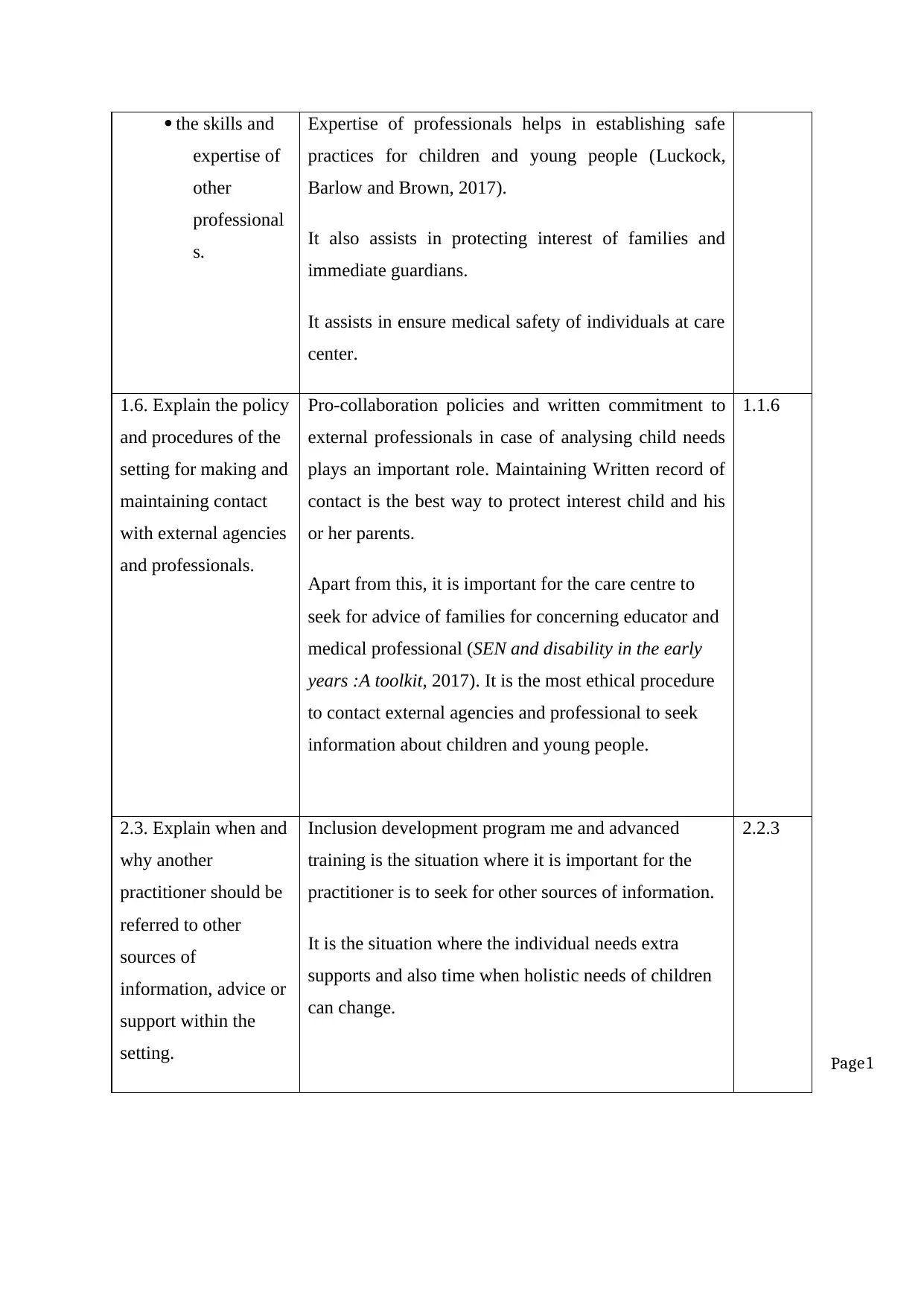
Page1
the skills and
expertise of
other
professional
s.
Expertise of professionals helps in establishing safe
practices for children and young people (Luckock,
Barlow and Brown, 2017).
It also assists in protecting interest of families and
immediate guardians.
It assists in ensure medical safety of individuals at care
center.
1.6. Explain the policy
and procedures of the
setting for making and
maintaining contact
with external agencies
and professionals.
Pro-collaboration policies and written commitment to
external professionals in case of analysing child needs
plays an important role. Maintaining Written record of
contact is the best way to protect interest child and his
or her parents.
Apart from this, it is important for the care centre to
seek for advice of families for concerning educator and
medical professional (SEN and disability in the early
years :A toolkit, 2017). It is the most ethical procedure
to contact external agencies and professional to seek
information about children and young people.
1.1.6
2.3. Explain when and
why another
practitioner should be
referred to other
sources of
information, advice or
support within the
setting.
Inclusion development program me and advanced
training is the situation where it is important for the
practitioner is to seek for other sources of information.
It is the situation where the individual needs extra
supports and also time when holistic needs of children
can change.
2.2.3
the skills and
expertise of
other
professional
s.
Expertise of professionals helps in establishing safe
practices for children and young people (Luckock,
Barlow and Brown, 2017).
It also assists in protecting interest of families and
immediate guardians.
It assists in ensure medical safety of individuals at care
center.
1.6. Explain the policy
and procedures of the
setting for making and
maintaining contact
with external agencies
and professionals.
Pro-collaboration policies and written commitment to
external professionals in case of analysing child needs
plays an important role. Maintaining Written record of
contact is the best way to protect interest child and his
or her parents.
Apart from this, it is important for the care centre to
seek for advice of families for concerning educator and
medical professional (SEN and disability in the early
years :A toolkit, 2017). It is the most ethical procedure
to contact external agencies and professional to seek
information about children and young people.
1.1.6
2.3. Explain when and
why another
practitioner should be
referred to other
sources of
information, advice or
support within the
setting.
Inclusion development program me and advanced
training is the situation where it is important for the
practitioner is to seek for other sources of information.
It is the situation where the individual needs extra
supports and also time when holistic needs of children
can change.
2.2.3
Paraphrase This Document
Need a fresh take? Get an instant paraphrase of this document with our AI Paraphraser
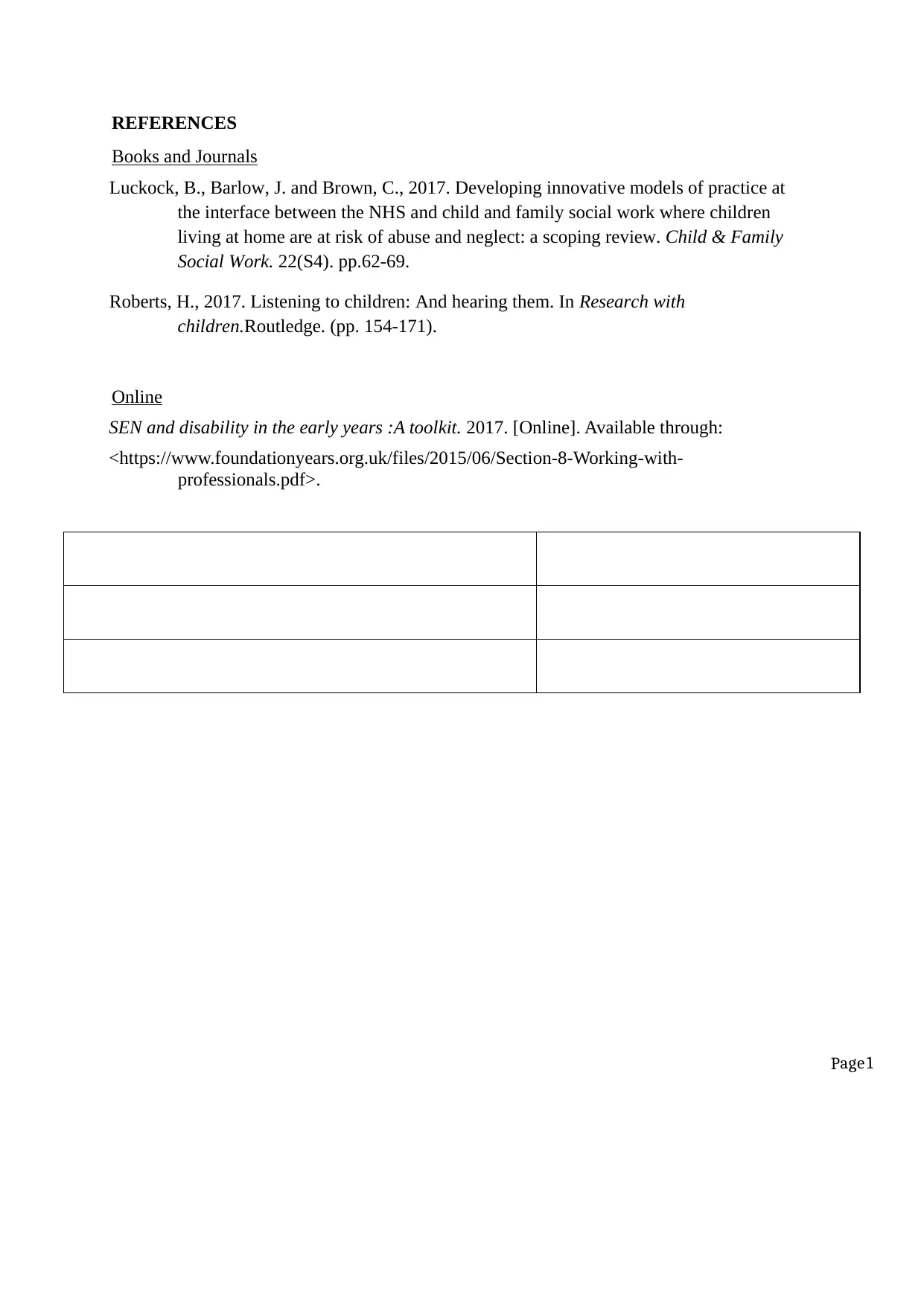
Page1
REFERENCES
Books and Journals
Luckock, B., Barlow, J. and Brown, C., 2017. Developing innovative models of practice at
the interface between the NHS and child and family social work where children
living at home are at risk of abuse and neglect: a scoping review. Child & Family
Social Work. 22(S4). pp.62-69.
Roberts, H., 2017. Listening to children: And hearing them. In Research with
children.Routledge. (pp. 154-171).
Online
SEN and disability in the early years :A toolkit. 2017. [Online]. Available through:
<https://www.foundationyears.org.uk/files/2015/06/Section-8-Working-with-
professionals.pdf>.
REFERENCES
Books and Journals
Luckock, B., Barlow, J. and Brown, C., 2017. Developing innovative models of practice at
the interface between the NHS and child and family social work where children
living at home are at risk of abuse and neglect: a scoping review. Child & Family
Social Work. 22(S4). pp.62-69.
Roberts, H., 2017. Listening to children: And hearing them. In Research with
children.Routledge. (pp. 154-171).
Online
SEN and disability in the early years :A toolkit. 2017. [Online]. Available through:
<https://www.foundationyears.org.uk/files/2015/06/Section-8-Working-with-
professionals.pdf>.
1 out of 5
Related Documents
Your All-in-One AI-Powered Toolkit for Academic Success.
+13062052269
info@desklib.com
Available 24*7 on WhatsApp / Email
![[object Object]](/_next/static/media/star-bottom.7253800d.svg)
Unlock your academic potential
Copyright © 2020–2025 A2Z Services. All Rights Reserved. Developed and managed by ZUCOL.



